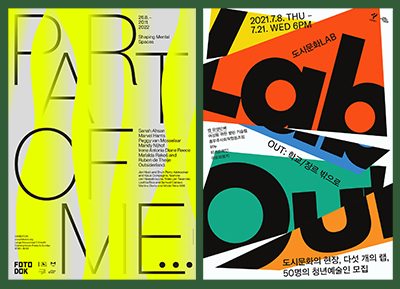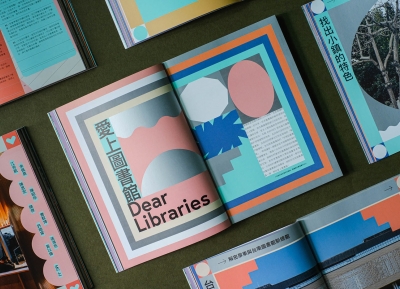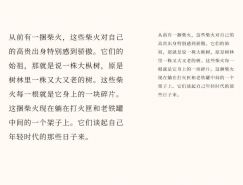(5)字符間距
圖片文字說明:
文字間距基礎
上:太緊
下:a和e的內部空間應該是相等的
平衡字符的內空間和外空間
Spacing. Some words about spacing type. Much more important than the shapes of the characters, is the rhythm of the type. A typeface with beautiful characters which are badly spaced is extremely hard to read. However, if the shapes of the letters are not that good, but when they are all perfectly spaced, the type will be fairly easy to read. Defining the rhythm is more important than defining the shapes.
字符間距
這里要說一下字符間距。字符的間距要比它的外形重要得多,這關系到字體的節奏。一種間距很糟糕的字體,不管外形如何優美,一樣難于閱讀。相反的,一款外形稍欠的字體,如果有完美的間距調節,這種字體一樣可以易于閱讀。因此,定義字體的節奏,要比定義字體的外形更加重要。
The white spaces inside and in between letters are defining the rhythm, much more than the black shapes of the letters. When you manage to create a good rhythm in your line of text, your type gets more readable and gives a balanced end result. While creating the black shapes, you have to take the white spaces into consideration. Because the white spaces are more important than the black shapes. However, white cannot exist without black. Changing a white shape, inevitable will have an influence on the black shape. From that perspective, one colour cannot be more important than the other.
字體的節奏取決于字符內部和字符之間的白空間,而非字符的黑色形體。如果你能夠為你的文本建立一種很好的節奏,你的字體就更易于閱讀,并獲得均衡的整體效果。從開始創建黑色形體的時候起,你就應該同時把白空間的設置考慮在內。當然,白空間和黑空間是相互依存的。白空間的改變也必然的會影響黑空間的形態。從這個角度來看,我們不能說黑與白哪個更重要。
For example, there has to be a relation between the space inside an 'n' and the space between the 'i' and the 'n' (see drawing). In the top row you can see the space inside the 'n' is much much bigger than the space in between the 'n' and the 'i'. In the bottom row they are much more equal, and in this way you'll get a much better rhythm and more harmony in your line of text.
例如,字母n內部的白空間,以及i與n之間的白空間,兩者之間必然會存在著某種關聯(見圖示)。在上面一行中,字母n內部的白空間要遠大于i與n之間的白空間。在下面一行中,兩者則要均衡得多,你也因而獲得了更好的節奏,整個文本也更和諧。
The same goes for the inner form of the 'a' and the 'e' for example. There is a big relation between these two forms. If they have (optically) the same amount of white inside the character (=counter), your type will have a better rhythm as well.
同樣的,小寫a和e之間的內部空間也存在著這種關聯。兩個形狀之間的關系非常緊密。這兩個字符的內部白空間(counter,中文術語翻譯為字懷/字谷/字幣)在視覺上應當是等量大小的,這樣你的字體才會有更好的節奏。
(6)黑與白
圖片上的文字:
注意字符內部和外部的白空間
Black vs. white. Designing type is nothing more and nothing less than harmonizing black and white shapes. Black can't exist without white, and white can't exist without black. Black, the shape of a letter. White, the space in or in between letters. The amount of white inside a character defines the amount of white in between two characters.
黑與白
字體的設計,莫過于調整黑白空間的和諧。黑不能離開白而獨立存在,白也是一樣。黑,是字符的形體。白,是字符內部和字符之間的白色空間。兩個字符之間白空間的大小,取決于字符內部白空間的大小。
As it is impossible to create a very black character with a big (white) counter form, a black typeface will always have smaller counters than a light typeface. Hence it follows that there is less space in between the characters (see drawing). A light typeface has much bigger counters. The space in between two letters has to be in proportion. As a consequence there is more white space in between light letters than in between black letters.
你永遠不可能設計出一種筆畫極其粗重而同時字懷(counter,字符內部包圍的白空間)又很大的的粗黑體。一個粗黑體,其字懷永遠要小于一個細線體,因而粗黑體的字符間距也一定要小于細線體(如圖)。細線體的字懷很大,其字符間距也必須相應的大,所以細線體的字符之間就需要比粗黑體更大的白空間。
(7)意大利體與草寫體
Italic vs. cursive. A roman font can be slanted (having an angle) and a cursive font can be upright (totally vertical like a roman). Urgh!
一個羅馬體(roman,通常也被譯作”正體“)可以是傾斜的(有一定的傾角),而一個草寫體可以是豎直的(就好像是一個正體一樣)。呃?!
The angle doesn't decide if a character is a 'roman' character or an 'cursive' character. This depends on the construction. To make it a bit more clear, take a look at the four big n's. As you would expect, the first letter is a roman character. But the second one as well. Although it's not totally vertical, it still has the same construction as the first 'n'. This is called a slanted roman. The third 'n' looks like an cursive, but also this one is not a real cursive. Basicly there is no difference between the second and third 'n', only some parts of the serifs have been cut off.
傾角并不能決定一個字母是一個“羅馬體”還是一個“草寫體”。關鍵在于其結構。要理解這一點,看看下面四個大n。你想的沒錯,第一個是一個羅馬體。但第二個同樣也是,雖然它并不是完全的豎直,它和第一個n擁有同樣的結構。這種情形我們叫做傾斜的羅馬體。第三個n看起來很象草寫體了。但它實際上還不是一個真正的草寫體。總的來說第三個n和第二個并沒有多大區別,只是襯線的個別部分被切掉了而已。
Compare the first three letters with the last 'n'. That's a real cursive. The big difference with the previous three is the construction. The first three are constructed from separate pen strokes. The last 'n' is constructed out of one pen stroke. This is the basic difference between roman and cursive fonts. Not the angle, but the construction.
與前面三個n相比,最后一個n才是真正的草寫體。它們之間最大的區別在于結構。前三個n的各個筆畫之間都是獨立的。最后一個n完全是一筆寫成的。這就是羅馬體和草寫體之間最根本的區別:不在于傾角,而在于結構。
Many different explanations can be given for the difference between a 'cursive' and 'italic' from a historical point of view. However we consider this as the big difference: 'italic' is concerning the function, 'cursive' is concerning the construction. Almost anything can work as an 'italic', it doesn't even necessarily needs an angle. When making a font family with a roman and an italic font, the italic font can be constructed in many different ways. The third 'n' in the example could probably function perfectly as an italic inside your family. But don't forget, it's not always a real cursive when it's called 'italic'.
如果要從歷史的視角來探討草寫體和“意大利體”之間的區別,那就說來話長了。但我們可以從這個角度來考慮:“意大利體”關乎功能,而“草寫體”關乎結構。幾乎任何字體都可以當成一個“意大利體”來使用,甚至根本不需要有什么傾角。當你制作一個包含“羅馬體”和“意大利體”的字體家族時,這個“意大利體”可以用各種不同的方式來構建。圖例中的第三個n也許就是你字體家族中一個完美的“意大利體”。但不要忘了,一個叫做“意大利體”的字體不一定是一個草寫體。
譯注:這篇翻的比較別扭。roman一般譯作“正體”,italic譯作“斜體”,嚴格來講都不是準確的翻譯,但卻已經是約定俗成的翻譯了。正確的翻譯應該是“羅馬體”和“意大利體”。在Windows上,對99%的用戶來說,italic就是斜體的意思,word里面甚至為所有字體都提供了一個“斜體”的功能。但實際上“意大利體”指的是一類字體的統稱,并且也并非所有的“意大利體”都是傾斜的。西方拉丁文字系統最早在古羅馬帝國形成完整的體系,代表作品就是古羅馬的石刻文字,非常莊嚴而典雅。而后來意大利人從手寫體中發展出了意大利體。隨著印刷術的發展,意大利體一般用來作為正文字體的一種特殊強調樣式,用于注釋、引文之類的場合,與正文字體相區別。因此許多比較完備的字體家族都提供了一個叫做“意大利體”的變體,和其正體(羅馬體)相比,有些字體中的“意大利體”的字形完全是經過重新設計的,而不僅僅是傾斜那么簡單。)
要了解更多有關意大利體的信息,可以參看下面這篇文章。
http://www.logosky.net/webpage/artreview/italic_font_20060916.htm
(8)風格的統一
圖上文字:
襯線還是無襯線?看上圖,你自己決定。
One for all What defines if one character can fit to another character? Once you made a decision, how to apply this to all the other characters in a font?
是什么決定一個字符能否匹配另一個字符?當你確定了一種風格,如何將之推廣應用于字庫中的全部字符?
Starting point: 'e' (in the center of the drawing). Imagine you sketched this 'e', you like it a lot, and now you want to design more characters fitting to this 'e'. Where to start? Should it be a serif or a sans serif for example?
先從這里開始:圖中有一個“e”。想象你剛畫好這個“e”的草圖,你很喜歡它,然后你想要設計更多的其他字符來匹配這個“e”。該如何開始呢?比如說,它應該是一個襯線字體還是一個無襯線字體呢?
First try: 'i' on the left. Sans serif. The black part is as thick as the black parts of the 'e'. Same x-height. So this should work you think.
第一個嘗試:左邊的“i”,無襯線體。它最粗的部分和“e”最粗部分的筆畫寬度相同,同樣的x-高度。它應該能表達你的想法了。
Second try: 'i' on the right. Same thickness, the character has the same x-height, but now it has serifs.
第二個嘗試:右邊的“i”。同樣的寬度,同樣的x-高度,但這次它有了襯線。
The bowl of the 'e' is not only having a certain thickness, but the 'e' also has contrast. The 'i' on the left has no contrast at all. Therefore these two characters don't belong to each other. The 'i' on the right however has the same kind of contrast as the 'e', just because it has serifs. Just those tiny serifs make sure there are thick and thin parts, like the 'e' has. This means that the starting point, the 'e', already defined that the rest of the font cannot be a sans serif typeface.
“e”的字碗不僅僅有著一定的寬度,同時還有著粗細的對比。左邊的“i”完全沒有筆畫粗細的對比。因此這兩個字符不是完美的一對。而右邊的“i”有著和“e”同樣的粗細對比,是因為它有了襯線。這細細的襯線讓它象“e”那樣擁有了粗細的區別。這就是起點。這個“e”,已經決定了這個字體中的其余字符不應該是一個無襯線字體。
Of course, every so called rule is there to be broken. Mentioning this, doesn't mean you can't make a font which has an 'e' combined with an 'i' like the one on the left. Everything is possible of course. But now you realize better what you are doing, also when you don't do it. Still get it?
當然了,每一條所謂的規則到最后都會有例外。從這個意義來說,你完全可以把中間的“e”和左邊的“i”配一對做一個字體。沒有什么是不可能的。但現在你已經能夠更深刻的意識到你為什么這樣做,抑或是你為什么不那樣做。還能理解嗎?
推薦設計

優秀海報設計精選集(8)海報設計2022-09-23

充滿自然光線!32平米精致裝修設計2022-08-14

親愛的圖書館 | VERSE雜誌版版式設計2022-07-11

生活,就該這麼愛!2022天海報設計2022-06-02
最新文章

圖片排版的17個實用技巧設計理論2019-06-21

2019-2020設計趨勢:Avatar角設計理論2019-06-13

2019-2020設計趨勢·IP形象篇設計理論2019-05-28

排版三要素:字號、行距設計理論2019-05-24












